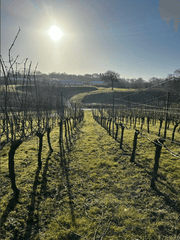
End of Pruning
BUY 6 BOTTLES & RECEIVE FREE DELIVERY

After a long 4 and a half months, pruning has finally come to an end here at Bluebell Vineyard. We began pruning work back in the second week of November where our field team would be out in the vines come rain, shine or occasionally even snow! We have over 100,000 vines across 3 different sites and we do all of our pruning by hand.
at Bluebell Vineyard. We began pruning work back in the second week of November where our field team would be out in the vines come rain, shine or occasionally even snow! We have over 100,000 vines across 3 different sites and we do all of our pruning by hand.
Pruning is a part of the vineyard process that involves cutting back parts of the vine to ensure that the plants energy is directed in the correct way. This is done with secateurs (casually known as snips). The cuttings are then ‘pulled out’ from the vines and left in the rows to be mulched by the tractor which composts them into the soil releasing nutrients back into the ground. Pictured below is a row of unpruned vines next to a row where pruning has been completed.

When Does Pruning Start?
To decide when to begin pruning we keep an eye on the conditions of the vines. When harvest ends in late October/early November we allow the vines to rest for a while. This allows the wood to ripen and the leaves to drop off. once this happens pruning can begin as we know the sap has stopped flowing.
Why prune?
Pruning optimises growth and yield for the upcoming year. Each vine only has a certain amount of energy which it can use to produce fruit so we want to make sure no energy is wasted and that it is focused on specific buds. If too many buds are left on the vine, the plant will create a weaker canopy which will in turn slow ripening, this could have a knock-on effect on the quality. If we don’t leave enough buds on the vine, it will create too much vigour in the canopy which would result in wasted potential.

Our pruning methods
We use two different pruning methods on our vines, Double Guyot/Cane Replacement and Cordon. Double Guyot means that we leave 2 canes and 2 spurs. This method ensures there are enough buds. We have observed that we seem to get better yields from this method. For Cordon we leave the 2 existing canes, which have become cordons, from the previous years and typically prune back each shoot to 2 buds roughly 15cm apart from each other. This is a quicker pruning method as it doesn’t involve needing to search for a new cane. Additionally, with this method no tying down is required.
We choose which method we use for each area by studying the vigour. We also study the best way to grow from various factors such as the soil type, positioning, sunlight and canopy heights. Our winemakers Kevin and Laurence can usually tell what pruning method would be best for each area from the previous years of working with these vines.
Next Steps
Now that our vines have all been pruned, we will continue tying them down and completing repairs to trellis work. Tying down is a process in which we use small ties to attach the new canes to the fruiting wire for stability. This means that when you have growth the canopy will grow upwards instead of out. In the winery, we are still blending the ferments from last years harvest and we are now just beginning to bottle the blends that Kevin and Laurence have deemed complete.

Canopy = all the green matter that is manipulated vertically, this could include shoots, leaves etc.
Vigour = how well the vine grows and becomes woody depending on nutritional availability.
Canes = what the shoots ripen into during October/November. These have 10-12 buds on them once pruned.
Spurs = deliberately pruned short, these have 2 buds on them and have the potential to grow as shoots and then become canes.
Bud = a growth on the vine with the potential to grow into the next years shoot/cane and will also produce flowers and fruit.
Subscribe to our emails